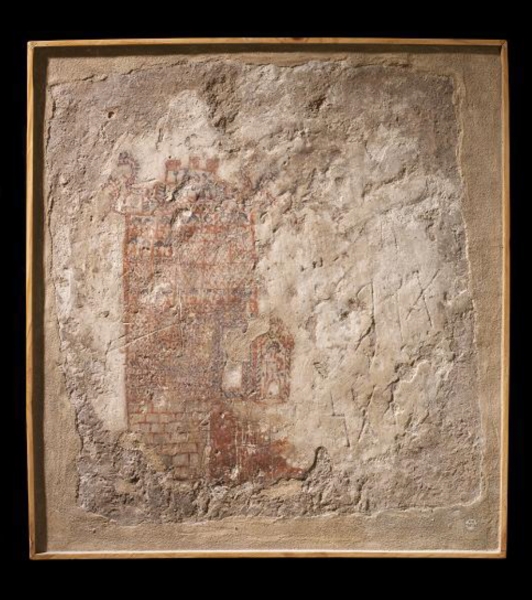
The Gypsum Mural is an ancient mural crafted and decorated on a gypsum surface in red and black colors. It was discovered in the archaeological Qaryat Al-Faw, located southeast of Wadi Ad-Dawasir Governorate in Riyadh Province, in the Kingdom of Saudi Arabia.
Description of the gypsum mural
The mural consists of the facade of a multi-layered house. On the lower left side, the house is depicted as being constructed from neatly arranged stones, forming several courses of interlocking stones. On the lower right side, the facade appears elevated and solid at the bottom, while the upper section is divided into two parts. The right part resembles a doorway with two side posts, each featuring two vertical lines separated by a gap crossed by slanted black lines. Above the doorway is an arch containing a depiction of a woman. She is illustrated with black hair, her left hand resting on her hip in a curved position, her feet apart, and a long neck. Her black hair is cut to the length of her neck. To the right of this depiction is another doorway with two side posts intersected by slanted black lines.
The right side of the mural is filled with red divisions, indicating that the building is constructed with interlocking stones. The remaining part of the mural is divided into several bands. The first band, located directly above the stone divisions, features opposing triangles with non-touching tips and no colors. Inside each triangle, there is a black dot. Next is a narrow band crossed by slanted vertical lines, followed by a wider band divided into eight squares, each filled with a network of lozenges. Inside each lozenge is a large black dot. After this, there is a thin band filled with opposing triangles that are colorless. Inside the triangles pointing upward, there are smaller black triangles with tips also pointing upward. This is followed by a similar band with comparable decorations. Above it, there is a band divided into ten rectangles, each containing the upper body of a woman in different poses. Above this is a band divided into five squares, each filled with a network of lozenges, with a large black dot inside each lozenge. Another band is divided into five horizontally aligned squares. The four squares on the left contain a network of lozenges with a black dot inside each lozenge. Next, there are two squares divided into four rectangles each, followed by a frieze at the bottom filled with opposing colorless triangles. Inside the upward-pointing triangles, there are black-painted triangles with tips pointing upward. This is followed by a band divided into seven rectangles and one square. The square contains the upper bodies of two women, while each of the six rectangles contains the upper body of a woman. Next to it, there is a band filled with alternating triangles, each containing a large black dot, followed by a narrow band filled with slanted vertical lines. Above this is a decorative band containing five script letters (Dhal, Sad, Ha, Ba, Ta), followed by a structure resembling a building with three balconies. Inside it is a horizontal rectangle containing four letters (Ta, Fa, Sad, Ya).
Dimensions of the gypsum mural
Length: 9.5 cm.
Head length: 2.5 cm.
Length from the chest to the bottom: Six cm.
Width of the lower abdomen: 1.8 cm.
History of the gypsum mural
The history of the gypsum mural dates back to the period between the third century BCE and the third century BC. The mural is preserved at the Archaeology Department Museum at King Saud University and is registered under number 29 F 22.
Significance of the gypsum mural
The artist of the mural successfully embodied the architectural concept as a central theme by depicting the architectural layout of multi-story buildings prevalent during that period. Repetition and symbolism are evident in this mural through the repeated human figures, while the symbolism can be observed in the ibexes, whose forms were utilized for decorative purposes.
Related quizzes
Related articles

